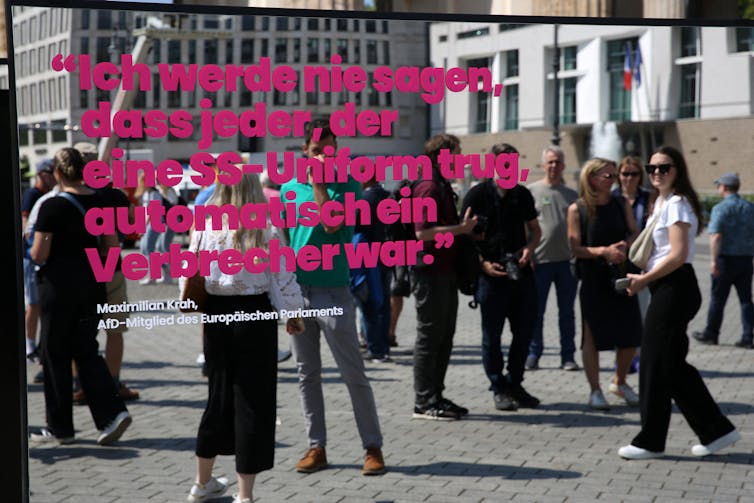The results of the 2024 European elections have confirmed the surge of far-right parties in EU member states. However, while many recorded significant scores, the wave was not a groundswell, and the shifts vary from country to country.
In 2019, far-right groups had a total of 165 elected members, or just over 20% of the total – taking into account the 29 seats of the Brexit Party in the United Kingdom. In 2024, taking all groups together, they could now win around 170 of the 720 seats in Parliament – approximately 24%.
This new distribution of seats should not mask major distortions due to the relative weight of the national representations. The largest contingents come mainly from France’s Rassemblement National (RN), Fratelli d'Italia, the Polish PiS, the German AfD and Hungary’s Fidesz. These five parties alone account for more than half of all far-right elected representatives.
Old and new players
Nevertheless, the results attest to the consolidation of the far right and its presence in virtually all EU member states – there are no fewer than 50 parties in Europe. To date, only Ireland and Malta remain untouched by the phenomenon.

In France, Italy, Poland, Hungary, Denmark and the Netherlands in particular, the far-right scene is made up of two, three and sometimes more parties. In France, there’s Rassemblement National and Reconquête, and in Italy, Fratelli d'Italia and the Lega. Alongside the major established players on the far right, new parties have emerged, including the Danish Démocrates (DD), Latvia First (LPV), Chega in Portugal and the AUR in Romania. Other movements have disappeared, particularly in Central and Eastern Europe, where party systems traditionally remain more fluid.
Varied performances
While the far right surged, the rise is far from uniform. The parties came out on top in France, Italy, Hungary and Austria. In the Netherlands, the Party for Freedom (PVV) was second behind the left-wing coalition, taking seven seats. Parties recorded their most significant vote gains in Belgium, Austria (+10 points), the Netherlands (+14 points), Bulgaria (+13 points) and Estonia. In Romania, the AUR improved on its score from the December 2020 legislative elections, with 14% of the vote and five seats.
In France, the far-right RN/Reconquête bloc took 37% of the votes cast, an all-time high. In Italy, the success of Giorgia Meloni’s party reflects the reconfiguration underway within the right-wing bloc and the decline of Matteo Salvini’s Lega: in 2019, Salvini topped the poll with more than 34% of the votes cast and 29 seats; in 2024, his party won less than 10%. In the Netherlands, the Forum for Democracy (FvD) lost most of its support from 2019, no doubt in part because of the PVV.
The far right has fallen back compared to 2019 in Hungary and especially in Poland, where the PiS has lost 12 points and eight seats in five years. Back in opposition since the October 2023 legislative elections, Jarosław Kaczyński’s party is partly suffering from competition from the Freedom and Independence Confederation, which is establishing itself at the heart of the Polish right with 12% of the vote and six seats. In Hungary, Viktor Orbán’s party is facing competition from the far-right Our Homeland Movement (MHM) and the new Respect and Freedom party (Tisztelet és Szabadság) led by Péter Magyar, which is further to the centre.
In Finland, the far-right party is paying for its participation in the government fell back sharply, losing 6 points compared to 2019. In Portugal, Chega failed to repeat its performance of last March’s general election and fell to 9% of the vote (two seats). The far right made only limited gains in Spain, where Vox has picked up three seats compared with 2019, and in Sweden, where the Democrats are more or less back to where they were five years ago.
In Germany, the AfD has plateaued at 16% of the vote behind the Social Democrats of the SPD – far less than the 22% that polls promised last January. The controversies surrounding the party’s “remigration” project and Maximilian Krah’s statements about the SS clearly outraged some voters.

The AfD is also facing competition on its left flank from the Sahra Wagenknecht Alliance (BSW), which is credited with 5% of the vote, on anti-immigration themes very similar to those of the AfD.
Successive layers of resentment

Across Europe, the popularity of far-right movements is rooted in the multiple crises to which EU citizens have been exposed since 2008 – the financial crisis, the 2015 refugee crisis, the Covid-19 pandemic and now the war in Ukraine. A sense-free amalgam perfectly summed up by the FPÖ’s slogan in the run-up to the vote: “Stop European chaos, the asylum crisis, climate terror, warmongering and Corona chaos.”
The economic context still weighs heavily on public opinion and fuels frustration and anger around rising the cost of living. The far right continues to capitalise on insecurities linked to immigration, which was a key issue in Germany, Poland and France. The war in Ukraine has also enabled parties such as the AfD and FPÖ to denounce governments doing their utmost to support Kiev, accusing them of “warmongering”. There has also been a backlash against the European Green Deal, with extremist groups attacking the environmental transition as being “punitive”.
In Italy, Giorgia Meloni was heavily involved in the European campaign, enabling her party to benefit from her relatively intact popularity as the head of government since September 2022.
The normalised far right
Finally, the rise in far-right parties reflects their growing “normalisation”. In the run-up to the elections, far-right parties such as Geert Wilders’ PVV and the RN in France moderated their positions on Europe, abandoning radical proposals such as withdrawing from the EU or creating a new Europe of “free and independent nations”. In many countries, the traditional right’s decision to echo issues dear to the far right gave the latter greater legitimacy.
Alone or in coalition, far-right parties are now in power in six EU countries: Italy, Finland and Hungary and, more recently, the Netherlands, Slovakia and Croatia. The Sweden Democrats are supporting the country’s centre-right government without taking part. The far right could soon enter governments in Austria or even Belgium.
What are the prospects?
It is still too early to comment on the impact of the vote, but the growth of the far right in a large number of member states will be a major challenge for the EU in the months and years ahead, particularly on issues of immigration, energy transition and support for Ukraine. Pro-European forces should retain a majority, but the increasing normalisation of the far-right players and their alliances with the traditional right-wing parties are underlying trends that will inevitably affect the future balance of power within the new parliament and in many EU member states.
The far right now faces the challenge of unity and its ability to bring together forces that are still divided within the parliament. While many of these parties are united in their opposition to immigration, their criticism of European integration and their rejection of the Green Pact, there are dividing lines around Ukraine, relations with Russia, the EU’s major economic and monetary policies and the defence of traditional values.
Added to this is the fact that these movements have integrated differently into their respective political systems. Alongside an “integrated” far right in Italy and the Netherlands, other movements have been kept at a distance from power, including France’s RN, Germany’s AfD, and Vlaams Belang in Flanders. Nationalist ultra-right movements such as Vazrazhdane in Bulgaria, the National Movement (Ruch Narodowy) in Poland, the Our Homeland Movement (MHM) in Hungary and the Croatian Fatherland Movement (DPMS) are more difficult to reach politically.
In this shifting extreme right-wing landscape, the big manoeuvres have begun, pointing to future recompositions.


